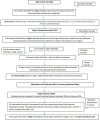Realist synthesis of intentional rounding in hospital wards: exploring the evidence of what works, for whom, in what circumstances and why
- PMID: 29540512
- PMCID: PMC6109250
- DOI: 10.1136/bmjqs-2017-006757
Realist synthesis of intentional rounding in hospital wards: exploring the evidence of what works, for whom, in what circumstances and why
Abstract
Background: Intentional rounding (IR) is a structured process whereby nurses conduct one to two hourly checks with every patient using a standardised protocol.
Objective: A realist synthesis of the evidence on IR was undertaken to develop IR programme theories of what works, for whom, in what circumstances and why.
Methods: A three-stage literature search and a stakeholder consultation event was completed. A variety of sources were searched, including AMED, CINAHL, MEDLINE, PsycINFO, HMIC, Google and Google Scholar, for published and unpublished literature. In line with realist synthesis methodology, each study's 'fitness for purpose' was assessed by considering its relevance and rigour.
Results: A total of 44 papers met the inclusion criteria. To make the programme theories underpinning IR explicit, we identified eight a priori propositions: (1) when implemented in a comprehensive and consistent way, IR improves healthcare quality and satisfaction, and reduces potential harms; (2) embedding IR into daily routine practice gives nurses 'allocated time to care'; (3) documenting IR checks increases accountability and raises fundamental standards of care; (4) when workload and staffing levels permit, more frequent nurse-patient contact improves relationships and increases awareness of patient comfort and safety needs; (5) increasing time when nurses are in the direct vicinity of patients promotes vigilance, provides reassurance and reduces potential harms; (6) more frequent nurse-patient contact enables nurses to anticipate patient needs and take pre-emptive action; (7) IR documentation facilitates teamwork and communication; and (8) IR empowers patients to ask for what they need to maintain their comfort and well-being. Given the limited evidence base, further research is needed to test and further refine these propositions.
Conclusions: Despite widespread use of IR, this paper highlights the paradox that there is ambiguity surrounding its purpose and limited evidence of how it works in practice.
Keywords: health services research; healthcare quality improvement; nurses; patient safety.
© Article author(s) (or their employer(s) unless otherwise stated in the text of the article) 2018. All rights reserved. No commercial use is permitted unless otherwise expressly granted.
Conflict of interest statement
Competing interests: None declared.
Figures
References
-
- Francis R. Report of the Mid Staffordshire NHS Foundation Trust Public Inquiry, Vol III, Present and future annexes. London: The Stationery Office, 2013.
-
- The Studer Group. Best practices: Sacred Heart Hospital, Pensacola, Florida. Hourly Rounding Supplement. Gulf Breeze, FL: Studer Group, 2007.
-
- Snelling P. Intentional rounding: a critique of the evidence. Nurs Times 2013;109:19–21. - PubMed
-
- Department of Health. Patients first and foremost: the initial government response to the report of the Mid Staffordshire NHS foundation trust public inquiry. London: Department of Health, 2013.
-
- Bartley A. The Hospital Pathways Project. Making it happen: Intentional rounding. London, UK: The King’s Fund Point of Care and The Health Foundation, 2017.
Publication types
MeSH terms
Grants and funding
LinkOut - more resources
Full Text Sources
Other Literature Sources
Medical
Miscellaneous

